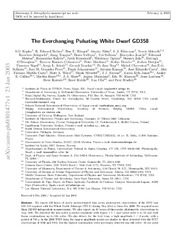The Everchanging Pulsating White Dwarf GD358
Permanent lenke
https://hdl.handle.net/10037/2036Dato
2003-01-23Type
Journal articleTidsskriftartikkel
Peer reviewed
Forfatter
Kepler, S.O.; Solheim, Jan Erik; Nather, R. Edward; Gonzalez Perez, Jose M.; Johannessen, Frank; Winget, Don E.; Nitta, Atsuko; Kleinman, S. J.; Metcalfe, Travis; Sekiguchi, Kazuhiro; Xiaojun, Jiang; Sullivan, Denis; Sullivan, Tiri; Janulis, Rimvydas; Meistas, Edmund; Kalytis, Romualdas; Krzesinski, Jurek; Ogloza, Waldemar; O’Donoghue, Darragh; Romero-Colmenero, Encarni; Martinez, Peter; Dreizler, Stefan; Deetjen, Jochen; Nagel, Thorsten; Schuh, Sonja L.; Vauclair, Gerard; Ning, Fu Jian; Chevreton, Michel; Kanaan, Antonio; Costa, Jos´e Eduardo; Costa, Alex Fabiano Murillo; Wood, Matt A.; Silvestri, Nicole; Ahrens, T.J.; Jones, Aaron Kyle; Collins, Ansley E.; Boyer, Martha; Mukadam, Anjum; Klumpe, Eric W.; Larrison, Jesse; Kawaler, Steve; Riddle, Reed; Ulla, Ana; Bradley, PaulSammendrag
We report 323 hours of nearly uninterrupted time series photometric observations of the DBV star
GD 358 acquired with the Whole Earth Telescope (WET) during May 23rd to June 8th, 2000. We acquired more
than 232 000 independent measurements. We also report on 48 hours of time-series photometric observations in
Aug 1996. We detected the non-radial g-modes consistent with degree ℓ = 1 and radial order 8 to 20 and their
linear combinations up to 6th order. We also detect, for the first time, a high amplitude ℓ = 2 mode, with a
period of 796 s. In the 2000 WET data, the largest amplitude modes are similar to those detected with the WET
observations of 1990 and 1994, but the highest combination order previously detected was 4th order. At one point during the 1996 observations, most of the pulsation energy was transferred into the radial order k = 8 mode, which
displayed a sinusoidal pulse shape in spite of the large amplitude. The multiplet structure of the individual modes
changes from year to year, and during the 2000 observations only the k = 9 mode displays clear normal triplet
structure. Even though the pulsation amplitudes change on timescales of days and years, the eigenfrequencies
remain essentially the same, showing the stellar structure is not changing on any dynamical timescale.
Beskrivelse
This is the authors' accepted version of the article.
Forlag
EDP SciencesSitering
Astronomy and Astrophysics 401, 639–654 (2003)Metadata
Vis full innførselSamlinger
Følgende lisensfil er knyttet til denne innførselen:


 English
English norsk
norsk